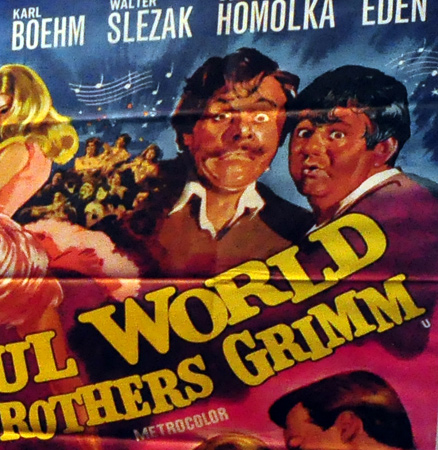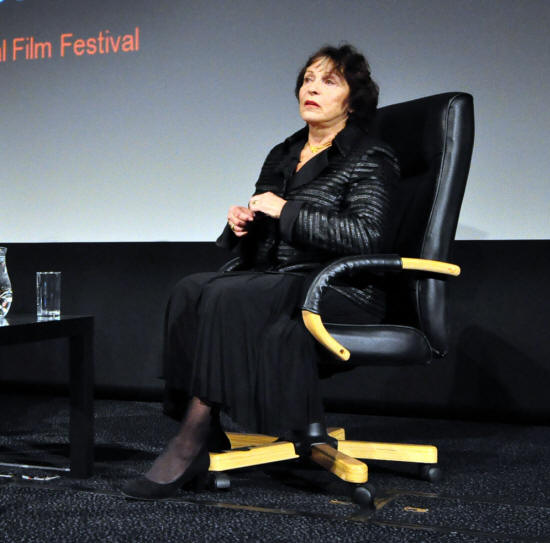The Wonderful World of the Brothers Grimm | Read more at in70mm.com The 70mm Newsletter |
| Review by: Mark Lyndon; 28.04.12, Pictureville Theatre, Bradford, England | Date: 28.05.2012 |
 On
the evening of Saturday, April 28th this year, delegates to the Wide Screen
Weekend strand of the Bradford Film Festival were granted the rarest of rare
treats, a screening of the only surviving three strip Cinerama print of
“The Wonderful World of the Brothers Grimm”. On
the evening of Saturday, April 28th this year, delegates to the Wide Screen
Weekend strand of the Bradford Film Festival were granted the rarest of rare
treats, a screening of the only surviving three strip Cinerama print of
“The Wonderful World of the Brothers Grimm”.The IB Technicolor print had come all the way from Australia to Bradford courtesy of the patron saint of Cinerama preservation, legend, and all round good egg, John Mitchell. We who cherish and prize genuine Cinerama will remain forever in his debt, and applaud his introduction into the illustrious pantheon of great cinema - The Widescreen Academy. This legendary “lost” Cinerama feature has held up well over the years and delegates were captivated and entranced by its old magic. For a fifty year old feel good film it still felt and looked pretty good. George Pal produced and directed the fairy tale sequences with Harry Levin for the real life drama. “The Wonderful World” is a skilfully scripted and acted production with some fine performances to enjoy from Laurence Harvey as the waifish, romantic and hopelessly impractical Wilhelm Grimm, and Karlheinz Bohm as his terminally exasperated brother Jacob. | More in 70mm reading: "The Wonderful World of Brothers Grimm" soundtrack released by Film Score Monthly Widescreen Weekend 2012 Speech for John Mitchell Interview with John H. Mitchell, Australia Claire Bloom visits Pictureville Cinema "Napoleon" Conquers USA Internet link: |
 Claire Bloom was in Bradford in 2011. Image by Thomas Hauerslev Claire Bloom was in Bradford in 2011. Image by Thomas HauerslevNoteworthy too was the quiet dignity of Claire Bloom as Dorothea Grimm, and Oscar Homolka as the farouche local Duke and employer from hell, fiercely insistent on the brothers producing and finishing an exhaustive account of his undoubtedly noble family history. Walter Slezak scores a minor triumph as Stossel, a local bookseller, urging Wilhelm to write books about “girls”- as far as a family film dared go in the early sixties. In response Wilhelm contrives an early form of market research, recruiting an ad hoc group of local children. He regales them with a romantic, but clean, tale of a lovelorn young royal, played by a much more confident (than in “The Time Machine”) Yvette Mimieux a princess with a penchant for going out masked at night and dancing the night away in a gypsy encampment. Her father, the king, a merry but murderous old soul, played by Jim Backus, recruits a humble woodcutter to spy on her nocturnal activities and report back on her exact movements. The axe stands ready for the woodcutter in the event of failure, half the kingdom and the hand of the princess upon success. Russ Tamblyn, as the woodcutter, is at last given a chance to display his formidable dancing skills. Yvette is no slouch either. They both execute a terrific, show stopping, pas de deux. Stand up Alex Romero, choreographer, who worked with George Pal on “Tom Thumb” and assisted in many an MGM musical including “Seven Brides...”, ”An American in Paris”, “Showboat” and “On the Town”. The princess vanishes with the woodcutter in hot pursuit, as Tamblyn tumbles we are treated to a tumbling point of view shot - not unlike the tumbling wagon in “How the West was Won.” The king is all too ready to have the woodcutter cut, but is reluctantly convinced; the princess insists that she has already given her heart to a masked stranger, whereupon the woodcutter unmasks himself, as it were, by donning the mask he wore in the gypsy encampment. They reprise their pas de deux and the whole court joins in. | |
 A final comic touch has the executioner pairing off with the court
jester. Roger Corman’s “Masque of the Red Death” later captured something of
this grotesque, gallows humour atmosphere, but in an altogether grimmer
form. A final comic touch has the executioner pairing off with the court
jester. Roger Corman’s “Masque of the Red Death” later captured something of
this grotesque, gallows humour atmosphere, but in an altogether grimmer
form.Pal’s formidable stop frame animation talents, long developed through “Paldoll” and, latterly, “The Puppetoons”, are finally revealed in the next tale: “The Cobbler and the Elves”: Here there is a clear and present danger of the production drowning in schmaltz. Pal skilfully manages to avoid this, just, with deft touches of leavening humour, and produces something quite unique in film history. This is stop frame animation Cinerama! Back in the “real world” in spite of the direst threats from the dyspeptic duke, Wilhelm continues his obsessive quest to transcribe an already vanishing oral tradition. Having been refused entry in no uncertain terms by the redoubtable Martita Hunt - a spellbinding story lady who in former times would almost certainly have been persecuted as a witch - he vainly pleads, “I am not as old as I look!” The line is beautifully reworked in the tale of “The Singing Bone” that follows. Buddy Hackett as the squire is almost devoured by a fearsome dragon and pleads -“I’m not as tasty as I look!” Terry Thomas brings out his long, noble and venerable lineage in portraying comic but convincing absolute cads, rotters and bounders as the cowardly and treacherous knight. The squire vanquishes the dragon, more by accident than design, only to be murdered by his master by a pool. That same reflecting pool shot was used by Peter Jackson in his “Lord of the Rings” to depict the murder by Gollum of his brother. Curiously enough, the first version of “The Singing Bone” featured fratricide - only to be vetoed by a squeamish MGM. After many seasons have passed, a bone belonging to the murder victim is unearthed by a passing shepherd. Played by the shepherd, the singing bone reveals the dastardly deed. The knight is confronted with singing evidence of his crime in a specially convened Royal Court. | |
 Puppetoon
from "The Wonderful World of the Brothers Grimm" on display in the Pictureville lobby during the Widescreen Weekend 2012. Image by Anders M
Olsson Puppetoon
from "The Wonderful World of the Brothers Grimm" on display in the Pictureville lobby during the Widescreen Weekend 2012. Image by Anders M
OlssonAn impressive display of Pal’s stop frame techniques transforms the bone into a skeleton, and finally a real live squire. The squire is reluctant to incriminate his master; nevertheless the court pronounces sentence.... Needless to say there is even more trouble, trial and tribulation to come for the brothers. Nevertheless, gentle reader, you will have certainly guessed the ending by now. A constantly recurring motif in “Brothers Grimm” is that of rescue. The wayward Wilhelm is repeatedly rescued by brother Jacob. The woodcutter is rescued by his quick wittedness from the executioner’s axe. The cobbler is rescued from his demanding clientele by the elves. The cobbler in turn rescues the orphan’s Christmas. The treacherous knight is rescued by his faithful squire from a fearsome dragon. His bone is rescued by the shepherd. The knight is rescued once again by the squire. Wilhelm Grimm is rescued on his deathbed by his own creations; he rescues them in return by naming them. The tales themselves, which are rooted but trapped in an oral tradition, are rescued for literature by Wilhelm Grimm. The reputation of the brothers for serious work is rescued by the Berlin Academy. The children of Berlin rescue the brothers from the Academy and too much seriousness. The very print exhibited to the delegates at the Bradford Film Festival Weekend was rescued by a kindly Australian archivist. The time has surely come for “The Wonderful World of the Brothers Grimm” to be rescued for the whole world to marvel at once more. | |
| Go: back - top - back issues - news index Updated 22-01-25 |
